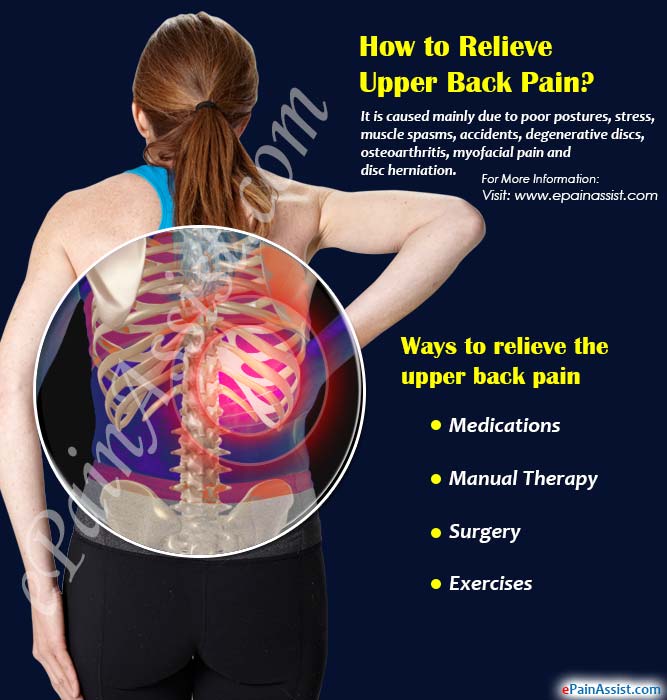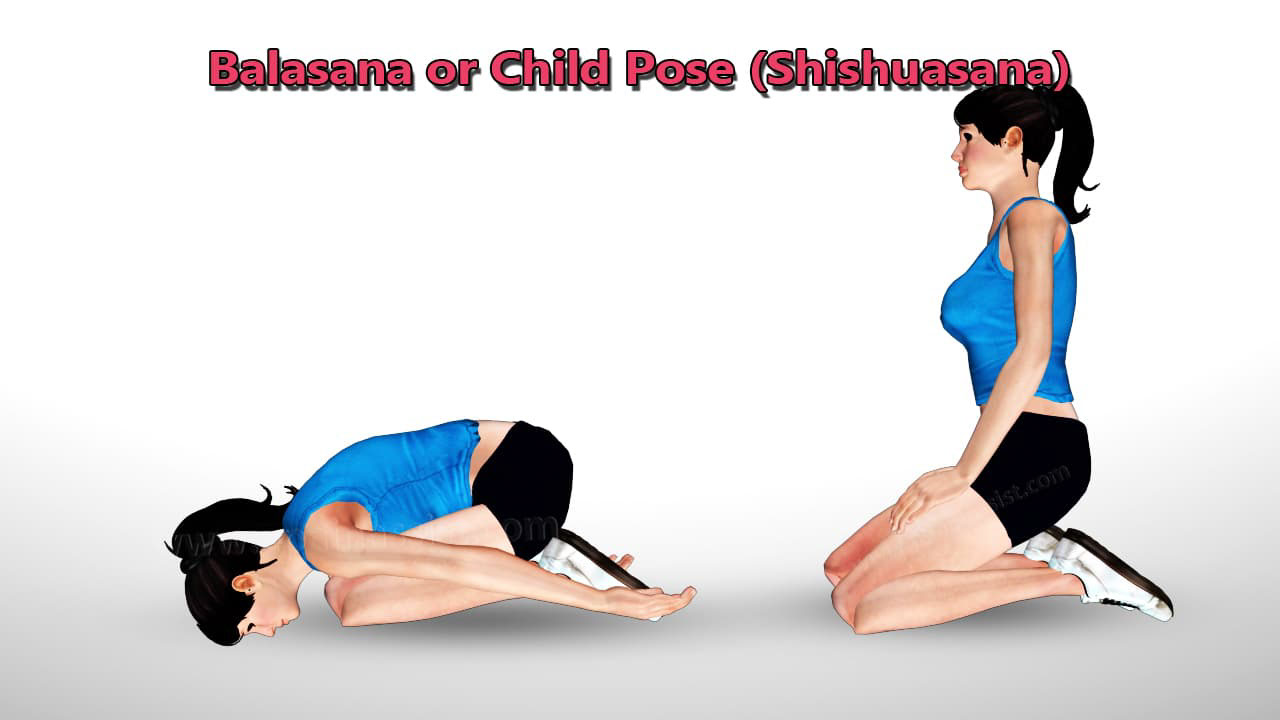The vertebral column (spine) is made of vertebrae which are separated from each other by the discs between them. The spinal column is divided into five parts as the cervical (neck) region, the middle thoracic (upper mid back) region, the lumbar (lower) region, the sacrum and coccyx. The cervical region is made of 7 vertebrae, the thoracic is made of 12 vertebrae, lumbar region is made of 5 vertebrae, sacrum of 5 vertebrae and coccyx of 1 vertebrae. The upper back consists of the neck and the upper thoracic vertebrae and the muscles and ligaments surrounding it. Pain in the upper back region is very common and experienced by almost all age groups of people.

Overview of Upper Back Pain
The upper back pain is found to occur in all age groups. It is caused mainly due to poor postures, stress, muscle spasms, accidents, degenerative discs, osteoarthritis, myofascial pain and disc herniation. This affects the joints and the interacting muscles. When one joint of muscle is affected, it affects others too, leading to pain and dysfunction. Further, it leads to stiffness in the neck and lower back. Thus, when the upper back pain is felt it should be treated immediately.
How to Relieve Upper Back Pain?
There are different ways to relieve the upper back pain these include:
- Medications to Relieve Upper Back Pain: Taking prescribed medicines, muscle relaxants, antidepressants and steroid shots can help in relieving upper back pain.
- Manual Therapy for Upper Back Pain:
- These include-
- Physiotherapy.
- Massage.
- Chiropractic Therapy: It is a type of an alternative medicine. Chiropractic care has been applied to treat problems with muscles, tendons, ligaments, joints, bones and spinal discs. The chiropractor uses manual method and hands on movements to treat musculoskeletal problems and corrects problems associated with the body mechanics by means of the joint adjustment. This approach helps to align the muscles and joints to their normal position, so that they can function correctly. This minimizes pain, strengthens the muscles and prevents further injury.
- Surgery for Upper Back Pain Relief: This mode of therapy is very rarely used in the treatment of upper back pain. The following are the types of surgeries used:
- Herniated Disc Removal: When discs present in between the vertebrae become big and push along the spinal canal, the herniated disc is removed to relieve the pressure and thus reduce the upper back pain.
- Kyphoplasty or Vertebroplasty: This type of procedure is used to fill the spaces between the vertebrae by injecting cement with a needle.
- Spinal Decompression: Due to stenosis, the space of the spinal canal gets narrowed. By using spinal decompression procedure, the narrowed space is made wide to relieve pressure on the spinal cord.
- Exercises to Relieve Upper Back Pain: Exercises are beneficial to the body in terms of making the body healthy and keeping it fit. In addition, they reduce pain present in the upper back region. The following are some of the exercises, which can be followed to get relief from upper back pain:
- Child Pose: One needs to first kneel on the ground, bend and touch the head as much close as possible to the ground. This is followed by stretching the hands forward and then backwards. Now, the head should be touched to ground and one should stay in that manner for a few minutes. Child pose yoga is effective in stretching your upper back muscles and providing relief from pain in the upper back.

- Sitting Rotation: To do this exercise, sit upright on the armrest chair. The body should be turned to the left slightly, but the neck should be kept straight. Next, the right hand should be placed on the left arm rest and hold the position for a few seconds. Again, come back to the starting position. The exercise must be repeated on the other side as well.
- Head Stretch: Sit upright on the floor with the head straight. Both the hands should be placed behind the head and the head should be pushed forward such that the chin is brought near to the chest area. One should hold in this position for 10 seconds and go back to the starting position. Head stretch can help relieve upper back and neck pain.
- Stick Position: Start the exercise by standing in an upright position and hold a long stick in hand. The hands should be stretched to hold the ends of the stick. Lower the hand and take it to the back and hold the stick under the neck. Then one should rotate to the right and be in this position for few seconds. This should be repeated on the other side too.
- Cat Stretch Position: One should be on all fours by placing both the palms and knees on the floor and the weight should be equally distributed on all four parts. The back should be flat. Now, take a deep breath so as to lengthen the spine. Now, without bending elbows or moving hips, roll the spine in order to arch the back. Lift chin, chest, and hips upward, thereby allowing the stomach to sink towards floor. Once you have reached maximum expression of arch, round up the spine upward and release head downwards. This needs to be done at least 10 times taking deep breaths while doing it. Cat stretch pose can be very effective in relieving upper back pain.
- Elbow Squeeze: One should stand straight and place the arms behind the back. The hands should be holding on to each other and the elbows should move towards each other by moving the head slightly backwards. Hold this position for 10 seconds and repeat the exercise 5 times. Elbow squeeze helps stretch your upper back muscles and can be effective in providing relief from upper back pain.
- Butterfly Position: Place the palms on the shoulders. By being in this position the elbows should be brought together until a stretch is felt in the upper back. One should hold in this position for 5 seconds and then return back to the starting position. This exercise should be repeated 10 times.
- Shoulder Roll Exercise for Upper Back Pain Relief: Standing in an upright position, the shoulders should be rolled in forward direction in large circles and then in small circles. This should be repeated by rolling shoulders in backward direction too. This exercise should be repeated for 10 times in each direction.
- Thoracic Stretch Exercise: One should sit on the floor with legs stretched in the front. The mid-thighs should be held with hands and the head and neck should be brought near to the abdomen. Hold the position for 5 seconds and repeat it 3 times.
- Aerobic Exercises: Aerobic exercises help to increase the blood flow to the spine and keep the intervertebral discs healthy. This minimizes the risk of upper back pain. Aerobic exercises can include-
- Exercising on stationery bike for 20 to 30 minutes.
- Exercising on treadmill for 20 to 30 minutes
- Isometric Exercises: These exercises are performed to push against resistance without moving muscles. This practice helps to strengthen the supporting muscles of the neck and the upper back. For doing the exercise, one should be in an upright position and put the palm on forehead and keep the neck steady. The palm should push the forehead while the forehead must resist the push with the muscles of the neck. This should be repeated on the right and left side of the head. It must also be done with the palm at the back of the head as well. This should be done for 10 seconds and should be repeated 5 times in each side.
- Child Pose: One needs to first kneel on the ground, bend and touch the head as much close as possible to the ground. This is followed by stretching the hands forward and then backwards. Now, the head should be touched to ground and one should stay in that manner for a few minutes. Child pose yoga is effective in stretching your upper back muscles and providing relief from pain in the upper back.
Performing exercises in an incorrect manner and excess of exercises can also lead to back problems. Hence, one needs to be careful with the choice of exercises and the extent to which they are supposed to be done. They should be performed under guidance of a good physical therapist and by taking advice of a doctor.
Home Remedies to Relieve Upper Back Pain
- Rest: One needs to take enough rest at home instead of putting stress on the spine by working in order to get relief from upper back pain.
- Medicines: Taking medicines such as acetaminophen and non-steroidal anti-inflammatory drugs as per the doctor’s advice is recommended.
- Applying heat to reduce pain and stiffness.
- Applying ice pack to reduce pain and swelling.
- Exercises: One should do exercises, which will help to stretch the back muscles and help to improve posture and reduce pain.
- Lifestyle Changes: Lifestyle changes would include-
- Eat nutritious food with plenty of calcium and Vitamin D to prevent bone fractures resulting from osteoporosis.
- Avoid smoking.
- To reduce stress by practicing yoga or meditation. One must consult a counselor if there are emotional problems.
- One should take more precautions and care while performing home based work.
Conclusion
The upper back pain whether mild or severe should be treated. Although medications may provide some relief, they fail to do so in the long run. Hence, performing correct exercises, taking alternative therapies and modifying the life style will lead to strengthening the muscles of the upper back and will provide relief from the pain.
Also Read:
- Upper Back Pain Information Center: Forestier’s Disease, Torticollis, HNP, Hunchback
- Inflamed Upper Back Muscles or Inflamed Cervical and Thoracic Muscle Attachments: Causes, Symptoms, Diagnosis, Treatment
- How to Relieve Upper Back Pain?
- How Can Yoga Help in Relieving Upper Back Pain?|Yoga Poses to Get Rid of Upper Back Pain
